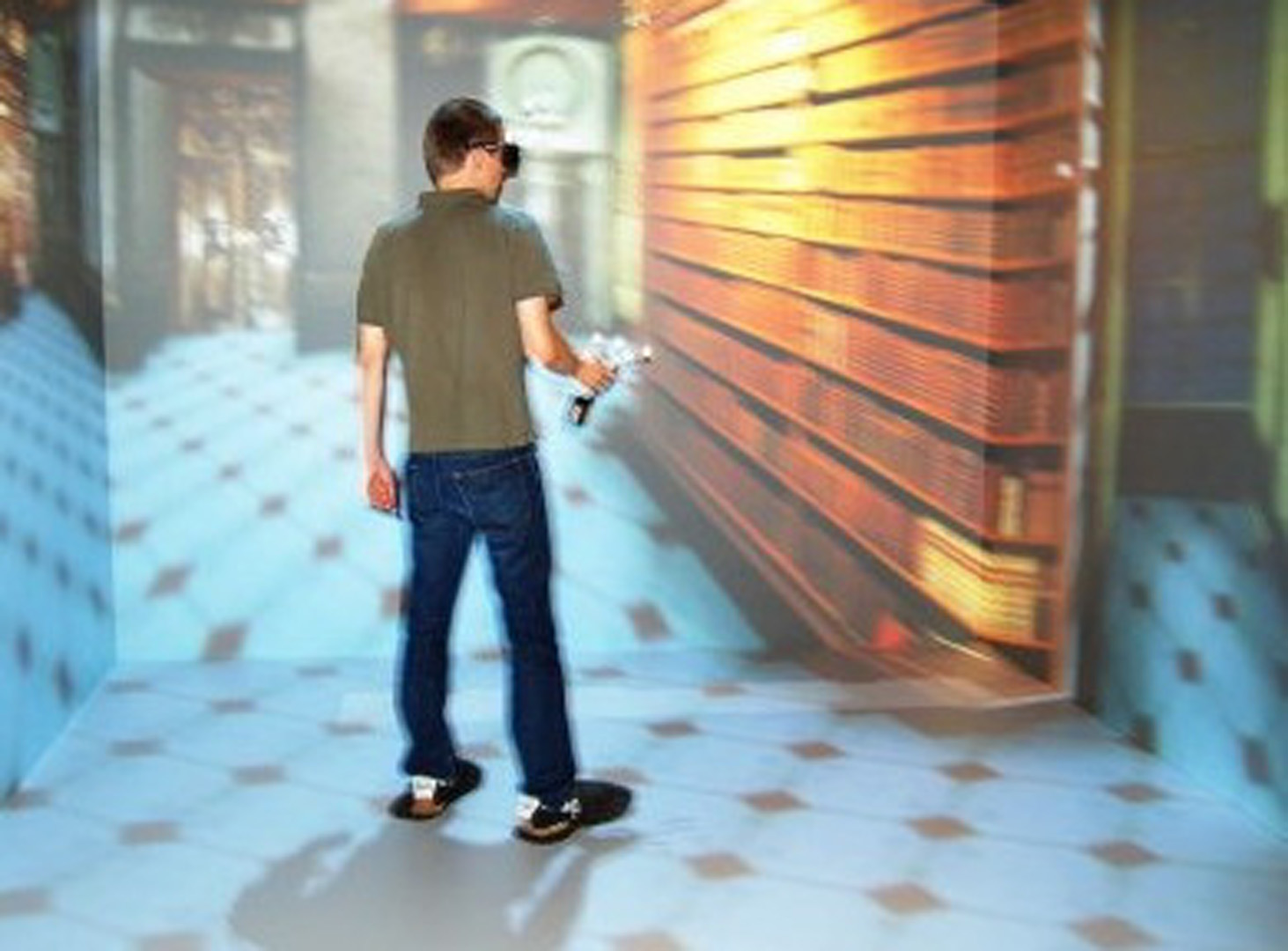“The holodeck construction manual” by Steinicke, Ropinski, Bruder and Hinrichs
Conference:
Type(s):
Title:
- The holodeck construction manual
Presenter(s)/Author(s):
Abstract:
Immersive virtual reality (VR) systems allow users to interact in virtual environments (VEs), where presence is limited to the virtual world; the physical surrounding cannot be perceived. Movie as well as scientific literature have reported about several of these interfaces that enhance presence of users in a VE, for example, the holodeck on the U.S. enterprise. Some of these immersive environments inspired researchers to provide at least a notion of an ultimate display, where the user cannot tell real from virtual [Sutherland 1965]. As shown in Figure 1 (right) in a six-wall CAVE the user is located in a cube on which sides stereoscopic content is projected from the back [Cruz-Neira et al. 1992]. Tracking of the user’s movements can be performed from outside, for example, by infrared-based approaches [Vorozcovs et al. 2005]. The most intuitive way of moving through such a scenario as well as through our real world is to perform real walking. Unfortunately, those setups provide only a limited interaction space in contrast to the potentially infinity VE. However, omnidirectional walking along arbitrary distance is essential for presence in VEs. Therefore, virtual locomotion interfaces are needed that support walking over large distances in the virtual world, while physically remaining within a relatively small space [Usoh et al. 1999]. Many hardware-based approaches have been presented to address this issue [Bouguila et al. 2002; Bouguila and Sato 2002]. Unfortunately, most of them are very costly, while
providing only a single user a notion of walking, and thus will prob-
ably not get beyond a prototype stage.
References:
1. Bouguila, L., and Sato, M. 2002. Virtual Locomotion System for Large-Scale Virtual Environment. In Proceedings of Virtual Reality, IEEE, 291–292.
2. Bouguila, L., Sato, M., Hasegawa, S., Naoki, H., Matsumoto, N., Toyama, A., Ezzine, J., and Maghrebi, D. 2002. A New Step-in-Place Locomotion Interface for Virtual Environment with Large Display System. In International Conference on Computer Graphics and Interactive Techniques (SIGGRAPH), ACM, 63–63.
3. Burns, E., Razzaque, S., Panter, A. T., Whitton, M., McCallus, M., and Brooks, F. 2005. The Hand is Slower than the Eye: A Quantitative Exploration of Visual Dominance over Proprioception. In Proceedings of Virtual Reality, IEEE, 3–10.
4. Cruz-Neira, C., Sandin, D. J., DeFanti, T. A., Kenyon, R., and Hart, J. C. 1992. The CAVE, Audio Visual Experience Automatic Virtual Environment. Communications of the ACM (June), 64–72.
5. Insko, B., Meehan, M., Whitton, M., and Brooks, F. 2001. Passive Haptics Significantly Enhances Virtual Environments. In Proceedings of 4th Annual Presence Workshop.
6. Jerald, J., Peck, T., Steinicke, F., and Whitton, M. 2008. Sensitivity to scene motion for phases of head yaws. In ACM Proceedings of Applied Perception in Visualzation and Graphics, (accepted for publication).
7. Kohli, L., Burns, E., Miller, D., and Fuchs, H. 2005. Combining Passive Haptics with Redirected Walking. In Proceedings of Conference on Augmented Tele-Existence, ACM, vol. 157, 253–254.
8. Peck, T., Whitton, M., and Fuchs, H. 2008. Evaluation of Reorientation Techniques for Walking in Large Virtual Environments. In Proceedings of International Conference on Virtual Reality, IEEE, (accepted for publication).
9. Razzaque, S. 2005. Redirected Walking. PhD thesis, University of North Carolina at Chapel Hill.
10. Steinicke, F., Bruder, G., Ropinski, T., and Hinrichs, K. 2008. Moving Towards Generally Applicable Redirected Walking. In Proceedings of Virtual Reality International Conference (VRIC), 15–24.
11. Steinicke, F., Welzel, H., Bruder, G., and Hinrichs, K. 2008. A User Guidance Approach for Passive Haptic Environments. In Proceedings of Eurographics Symposium on Virtual Environments, 31–34.
12. Sutherland, I. 1965. The Ultimate Display. In Proceedings of IFIP Congress 2, 506–509.
13. Usoh, M., Arthur, K., Whitton, M., Bastos, R., Steed, A., Slater, M., and Brooks, F. 1999. Walking > Walking-in-Place > Flying, in Virtual Environments. In International Conference on Computer Graphics and Interactive Techniques (SIGGRAPH), ACM, 359–364.
14. Vorozcovs, A., Hogue, A., and Stuerzlinger, W. 2005. The Hedgehog: A Novel Optical Tracking Method for Spatially Immersive Displays. In Proceedings of Virtual Reality, IEEE, 83–89.





